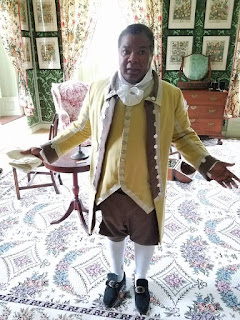The novelty of this type of space would have been only the beginning of the decadence of this room when the Schuylers entertained guests. Polished silver and wood work, shining mirrors, exotic fruits, and elegant twisted-stem glassware reflected a deep sense gentility. The silver epergne on the side board, which displayed fruits, desserts or garnishes, is an original family piece, engraved with Schuyler's crest.
Hanover, a child born into enslavement at the house], clad in bright yellow livery coats waited upon the Schuylers and their guests at meals. The absence of windows along the east wall helped to hide the labor taking place in the courtyard from view, including the food preparation, which was done by enslaved women in a detached kitchen [read about uncovering the identities of these female slaves]. The door on the east wall would have led into a covered walkway that attached the working buildings of the courtyard and allowed food to be brought directly into this space.
On the same wall are portraits of middle son Philip Jeremiah and his second wife, Mary Ann Sawyer. Philip Jeremiah attended Trinity College (formerly Kings College, currently Columbia University) and became a New York State Assemblyman, and is often considered the most successful of the three sons. The second youngest daughter, Cornelia, is depicted on the south wall with her husband, Washington Morton, with whom she eloped in October of 1797. Morton claims that Cornelia leapt from a second-story bedroom window in order to elope with him, but other parts of the story (and common sense) suggest that this was exaggeration. All four paintings are by artist Thomas Sully, who was commissioned by the two couples in turn to paint portraits as gifts to one another. Sully also painted the portrait of president Andrew Jackson which is currently on the US twenty dollar bill.
As You Exit :
You will pass through the Back Hall
Left will bring you to the Central Hall
Straight ahead, you will find the Library
Right will bring you upstairs into the Salon
Other Rooms:
Formal Parlor
Family Parlor
Blue Chamber (Upstairs)
Yellow Chamber (Upstairs)
Green Chamber (Upstairs)




No comments:
Post a Comment